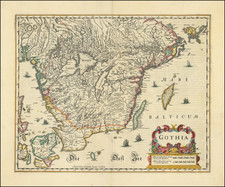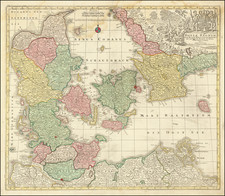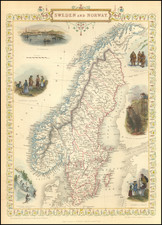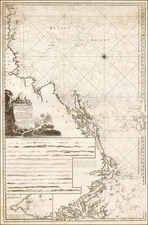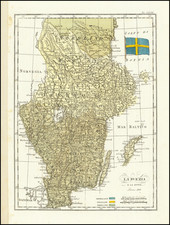Finely colored example of Braun & Hogenberg's map of the Island of Hven, most notable for being the site of Tycho Brahe's observatory, Uraniborg. The map shows the island oriented with the west at the top, which was a common mapping convention of the era.
In the top left corner, there is a detailed illustration of Uraniborg, depicting its grand structure and the symmetry of its design. Below this illustration is the ground plan of the observatory, showing the organized layout of the rooms within Uraniborg.
The main part of the map provides a view of the island itself, with its fields, buildings, and surrounding waters. This depiction suggests a tranquil, well-ordered place with a mix of natural and human-made features.
On the top right, an inset likely shows some of the scientific instruments used in astronomy or diagrams related to Brahe's work, reflecting the island's significance in the history of astronomical observation.
The text on the bottom left is a title and description, while the text on the bottom right provides additional context about the island and Tycho Brahe's activities there, mentioning the island's agriculture, wildlife, and fishing potential.
Overall, the map serves as a historical document detailing the site of significant scientific study in the late 16th century, offering insight into both the geography of the Island of Hven and the scientific endeavors of Tycho Brahe.
Georg Braun (1541-1622) was born and died in Cologne. His primary vocation was as Catholic cleric; he spent thirty-seven years as canon and dean at the church St. Maria ad Gradus, in Cologne. Braun was the chief editor of the Civitates orbis terrarum, the greatest book of town views ever published. His job entailed hiring artists, acquiring source material for the maps and views, and writing the text. In this role, he was assisted by Abraham Ortelius. Braun lived into his 80s, and he was the only member of the original team to witness the publication of the sixth volume in 1617.
Frans Hogenberg (ca. 1540-ca. 1590) was a Flemish and German engraver and mapmaker who also painted. He was born in Mechelen, south of Antwerp, the son of wood engraver and etcher Nicolas Hogenberg. Together with his father, brother (Remigius), uncle, and cousins, Frans was one member of a prominent artistic family in the Netherlands.
During the 1550s, Frans worked in Antwerp with the famous mapmaker Abraham Ortelius. There, he engraved the maps for Ortelius’ groundbreaking first atlas, published in Antwerp in 1570, along with Johannes van Deotecum and Ambrosius and Ferdinand Arsenius. It is suspected he engraved the title page as well. Later, Ortelius supported Hogenberg with information for a different project, the Civitates orbis terrarium (edited by Georg Braun, engraved by Hogenberg, published in six volumes, Cologne, 1572-1617). Hogenberg engraved the majority of the work’s 546 prospects and views.
It is possible that Frans spent some time in England while fleeing from religious persecution, but he was living and working in Cologne by 1580. That is the city where he died around 1590. In addition to his maps, he is known for his historical allegories and portraits. His brother, Remigius, also went on to some fame as an engraver, and he died around the same time as his brother.









